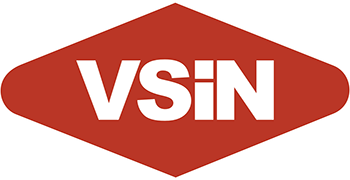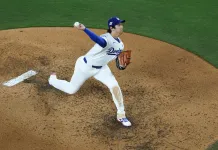Cubs vs. Brewers
Milwaukee won the NL Central by five games over Chicago, but this Cubs vs. Brewers series in the NLDS gives the second-place finishers the opportunity to win when it really counts. We just saw the Tigers do that to the Guardians in the AL Wild Card Round and now we’ll see if the Cubs can do it.
From a head-to-head standpoint, the Cubs went 7-6 over the 13 games and outscored the Brewers 60-56, but the results were all over the place. That type of record and run differential would normally imply a lot of one-run games. Of the 13 meetings, only two of them were one-run results. The teams last played against each other August 21, a 4-1 win for the Brewers.
Milwaukee finished the regular season 52-29 at home with a +77 run differential and 45-36 on the road with a +95 run differential, so they excelled regardless of where they played. Chicago was 50-31 at home with a +67 run differential and 42-39 with a +77 run differential. So, they, too, were good more often than not. The Division Series has the 2-2-1 format. There is an extra day off on Sunday to separate the AL and NL series for TV viewing purposes.
Let’s break down the three main phases of the game – offense, pitching, defense – and see if there’s an edge to be had.
Cubs vs. Brewers NLDS Odds
Chicago Cubs +105 // Milwaukee Brewers -125
Over/Under 3.5 Games (-350/+265) // Over/Under 4.5 Games (+150/-180)
Odds as of 9 a.m. PT from DraftKings Sportsbook on Friday, October 3
Cubs vs. Brewers NLDS Preview
Offense
I will start by saying that the Brewers perplex me in this series and in the playoffs. I think of this group as a team that is built really well for the regular season. They were third in runs scored with 806, one of just three teams with 800+ runs (Yankees, Dodgers), but 22nd in home runs. If you read any of my series previews for the Wild Card Round, you know that I could not express enough how much power matters in the playoffs. The run environment is much tighter, strikeouts go up with better arms being sent out there, and manufacturing innings is very difficult.
The Brewers are a team that manufactured innings. They led the NL with 164 stolen bases. They were second in OBP at .332 and second in BABIP at .305. By the all-encompassing FanGraphs’ baserunning metric BsR, they were the best team in the league. They were just 12th in SLG. They led the league in singles with 974, a whopping 122 more than the Cubs. But, the Cubs had more doubles (2), more triples (11), and more home runs (57).
I do think that this is a better matchup for the Brewers than facing the Phillies or Dodgers, though. This is a contact-oriented lineup that puts pressure on the defense. Teams with higher-strikeout pitching staffs can overpower some of these guys and really limit hard contact. As it is, the Brewers were held to a 39.2% Hard Hit% that ranked 25th and the second-lowest Barrel% in the league at 6.7%. It is not a coincidence, at least not to me, that the lower team in Barrel% lost in all four Wild Card series. The teams that advanced ranked 1st (NYY), 4th (LAD), 5th (CHC), and 7th (DET) in Barrel%. The teams that didn’t ranked 8th (BOS), 27th (SD), 28th (CIN), 30th (CLE).
As far as splits go, the Brewers were ninth in wOBA against lefties and the Cubs were sixth. Chicago only had 1,588 plate appearances against southpaws compared to 1,821 for Milwaukee. Yet, they still hit 22 more homers than the Brewers did in that split.
The Cubs also finished stronger against righties with a .325 wOBA compared to a .322 wOBA. The Cubs had 168 more plate appearances and hit 35 more homers.
All in all, the Cubs scored 13 fewer runs than the Brewers. Obviously the power and contact authority discrepancies likely should have pushed the Cubs in front of the Brewers, but the Brewers did hit .279 with runners in scoring position and had a .318 BABIP compared to the Cubs hitting .267 with a .298 BABIP. Milwaukee is going to have to stay on that type of path with RISP to perform offensively in this series.
With the power advantages for the Cubs, I think they are the better offense for this run environment.
Advantage: Cubs
Pitching
What could shift the balance of power, pardon the pun, in Milwaukee’s favor on offense is the home run prevention skills of their pitching staff. This is not an overpowering group by any means, but they collectively finished second in ERA at 3.59, third in xERA at 3.81, and sixth in FIP at 3.91. The Brewers had the third-best HR/FB% against at 10.5%. So, if they are able to keep avoiding the barrel, which they were the fourth-best staff at doing, that could change the dynamics of this series.
The Cubs held the Padres to just five runs over three games in the Wild Card series. They were ninth in ERA in the regular season at 3.81, but 15th in xERA at 4.06 and 20th in FIP at 4.16. Of course, Cade Horton played a sizable part in that effort, but he’s out for the season. One of the downsides to playing in the Wild Card round is that it does alter the pitching plans for a team, so the Cubs will have to hold back Matthew Boyd until Game 2. That means former Brewer Colin Rea likely gets the Game 1 nod.
However, one other thing to think about is that Milwaukee’s pitchers have had to stay sharp with bullpens, side sessions, long toss, and intrasquad scrimmages. Since the best-of-three Wild Card series was introduced in 2022, the teams that got the byes are 6-6 in the Division Series round. I think part of that, and especially with the Sunday off day for the two NLDS series, is that you have pitchers out of their routines and on extended rest.
Game 1 starter Freddy Peralta last pitched on September 28, but he only threw two innings and faced nine batters, so he’s gotten six outs since September 22. Likely Game 2 starter/bulker Quinn Priester hasn’t pitched since September 26 and he’ll get the October 6 start in this series. Like Game 3 starter/bulker Chad Patrick hasn’t made a start since September 24 and threw one inning in relief on September 28. He’s faced more than 12 batters once since September 9 and won’t start/bulk in this series until October 8.
Then you also have to factor in the relievers. Sure, the Cubs bullpen put some extra miles on their arms in the series against the Padres, but those guys are used to working frequently. We’re talking about relievers for the Brewers that haven’t pitched since Sunday or farther back.
Obviously Milwaukee will be aggressive using their bullpen, which was very good and now has several multi-inning options, including rookie flamethrower Jacob Misiorowski. I don’t think there will be a lot of traditional starts for the Brewers in this series or throughout the postseason, with the exception of Peralta.
I don’t know that there’s a huge pitching advantage because the Brewers are the better overall pitching staff, but I do worry about those extended layoffs. I also worry about Craig Counsell being more proactive with pulling Shota Imanaga so that righties don’t burn him the second time through the order like Manny Machado did in Game 2.
Advantage: Brewers slightly
Defense
These are two spectacular defensive teams. The Cubs were +34 Outs Above Average per Statcast and the Brewers were +29. And they are similar in terms of where they excelled. The Cubs were +21 OAA in the outfield and the Brewers were +17, ranking second and third in the league, respectively. They were 10th and 11th in OAA on the infield.
William Contreras was a little better at framing than Carson Kelly, but Kelly was very good at controlling the running game. He was +5 CS Above Average per Statcast. Contreras was +3 and the Cubs do like to run a bit as well.
The aggression on the bases usually goes down in the playoffs because of how strikeout-heavy the games are, so losing out on a baserunner can be quite damning. However, these are two teams that do like to play with an edge. Milwaukee has to given their lack of power. The Cubs did not steal any bases in their series against the Padres, but San Diego did steal three bases, the same number as every other team combined.
Milwaukee was 8-for-11 stealing bases in the 13 head-to-head meetings. The Cubs were only 3-for-6.
This is an advantage for both, especially because American Family Field ranks 24th in Statcast Park Factor over a three-year rolling period. Wrigley Field ranks 27th. Obviously Wrigley is pretty wind-dependent, but it’s cooling off now and we saw the wind mostly blowing in for the San Diego series.
Advantage: Cubs slightly?
Cubs vs. Brewers Prediction
A very tough series to figure out here, as these two teams are so similar in so many ways. There is one difference, though, and it is something I harped on for the Wild Card series. The Cubs hit for more power. Chicago slightly out-homered Milwaukee 17-15 during the regular season over those 13 head-to-head meetings.
Like I said, the team with the higher regular season Barrel% went 4-0 in the Wild Card round. With the uptick in average fastball velo and the inability to really string hits together, I think it’s extremely valuable to hit the long ball. And Chicago is better equipped for it, so I like them as a series underdog here.
That being said, the Brewers are around -160 for Game 1 and the Cubs are around +130 with a series price of +105. They can win the series losing Game 1, but obviously they’d be at a much stronger series price than what’s there now. So, I’m not sure that +105 is the best way to attack this, but I do think they advance. Doubling down with Game 1 and then a series price if they lose also creates more exposure, so I’ll be thinking about this one probably up until first pitch.
Pick: Cubs +105
Other Division Series Previews: Yankees vs. Blue Jays | Dodgers vs. Phillies | Tigers vs. Mariners






